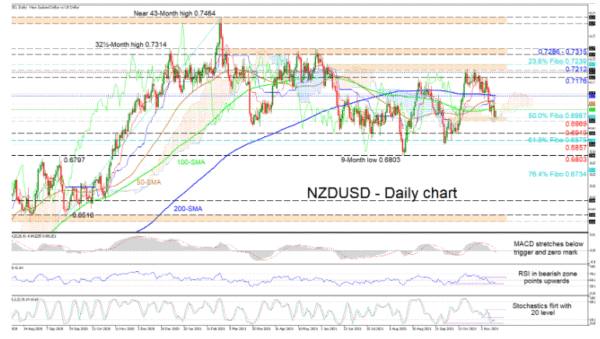NZDUSD has established a strong foothold in the vicinity of a support zone that has formed between the 0.6987 and 0.6969 levels, the former being the 50.0% Fibonacci retracement of the up leg from 0.6510 until the near 43-month peak of 0.7464. The longer-term 100- and 200-day simple moving averages (SMAs) are reflecting a trendless trajectory in the pair, while the recent dip in the 50-day SMA is suggesting that sellers have a slight lead.
The Ichimoku lines are not sponsoring any clear price direction, while the short-term oscillators are transmitting mixed signals in directional momentum. The MACD has extended beneath its red trigger line and further into the negative region, while the RSI is pushing higher in the bearish territory. Currently, the stochastic lines are failing to exhibit any clear directional impetus in the pair.
If buyers fail to create upside pressure, immediate downside constraints could emanate from the 0.6969-0.6987 support band and the overlapping cloud. Should this tough barricade give way, the price may plunge towards the 0.6910 low before the bears target the 61.8% Fibo of 0.6875 and the adjacent 0.6857 trough. Sinking past these obstacles, traders’ attention could then turn towards the nine-month low of 0.6803.
If bullish traction evolves, a preliminary zone of resistance could take shape between the 100- and 50-day SMAs at 0.7022 and 0.7051. Should upside forces persist, the 200-day SMA at 0.7087 and the nearby 0.7100 handle could come into the picture. Failing to dampen buying powers, the price may then propel for the 0.7176 high prior to challenging the 0.7200 barrier, and the resistance boundary from the 0.7212 mark until the 23.6% Fibo of 0.7239.
Summarizing, in the short-term picture, NZDUSD appears somewhat stuck in a neutral phase. For a definitive price direction to materialise, the price would need to conquer the 0.7286-0.7315 ceiling or extend a dive past the 0.6803 trough and below the 76.4% Fibo of 0.6734.













